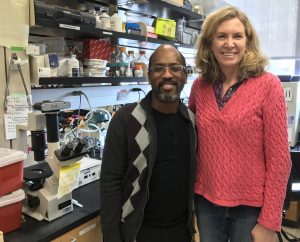It all started with one course offering — Introduction to Neuroscience — in 2001. Then, due to that class’ popularity, more and various courses were presented, and a neuroscience minor was born in 2004. Now, after 19 years to “grow up,” a full-fledged neuroscience major will be offered at Hope College starting with the 2019-20 academic year. The growth of those neuroscience offerings, along with student interest, are due in no small part to the work of the program’s first parent, founding director Dr. Leah Chase, and now its adoptive and new leader, Dr. Gerald Griffin.

The way one neuroscience class resulted in an eventual major is not surprising, given Hope’s solid scientific reputation, yet adding a new major program was not initially the plan, Chase says. The plan was to offer that one class to employ Chase’s teaching know-how (she’s an associate professor of both biology and chemistry) and research specialty (on neurotransmitter systems) while satisfying expressed interest that Hope students were voicing.
“It was a long journey, but there were important landmarks along the way.”
“To be perfectly honest, back then a major wasn’t even the goal,” says Chase. “The first goal was to offer the neuroscience class here with a supporting lab to go with it. We got the grant from NSF (National Science Foundation) to create that lab and from there we weren’t sure yet where it would go.”
Student interest remained strong, and with the 2015 faculty additions of Griffin, associate professor of biology and psychology, and Dr. Andrew Gall, assistant professor of psychology, a new major in neuroscience made every sense to add to the list of Hope’s 80-plus majors, minors and pre-professional programs.
“It was a long journey, but there were important landmarks along the way,” says Chase. “Getting Gerald and Andy to Hope was really important, so was having dedicated neuroscience lab space (in the Schaap Science Center) and getting a grant from HHMI (Howard Hughes Medical Institute) which included support for the development of the neuroscience minor. All of that made going from a minor to a major at this time seem like the perfect fit.”
Neuroscience — the study of the brain and nervous system to better understand human behavior — naturally blends the academic worlds of biology, chemistry and psychology. At Hope though, it’s more than that. Students who major in neuroscience also must select from a list of classes in engineering, computer science, physics, mathematics and philosophy for a total of 63 to 67 credits. With such a breadth of requirements across several disciplines, the neuroscience major leans heavily into Hope’s liberal arts tradition.
“We spent a long time thinking about how we would design this major,” says Chase, who has served on the governing board of Faculty for Undergraduate Neuroscience and currently serves as vice president of the Kenneth H. Campbell Foundation for Neurological Research. “All of us were sitting there looking at other programs, and we wanted to be sure two things happened with ours. One, it had to fit well with national norms for neuroscience study and, two, it had to have a very unique Hope-College stamp on it.”
Neuroscience naturally blends the academic worlds of biology, chemistry and psychology. At Hope though, it’s more than that.
Signs that the new neuroscience major has the Hope College mark written all over it will be seen as neuroscience students become active in programs such as Memory and Music — helping patients with dementia augment memories by playing music from earlier decades. Hope’s Brain Days and Brain Awareness Week teaches elementary students about neuroscience fundamentals through a science fair. Taking classes like Philosophy of Science or Medical Ethics will provide a holistic preparation that produces ethically-rooted scientists. Exploring phantom limb pain with Dr. Katharine Polasek in Hope’s engineering department, or discovering the biomarkers of apathy in patients with Alzheimer’s disease with Dr. Emilie Dykstra Goris in Hope’s nursing department is yet another way neuroscience “will have the kind of interesting overlaps that only Hope can provide,”
Of course, research opportunities — another Hope trademark — will begin as early as students’ Introduction to Neuroscience course and continue through advanced neuroscience core courses as well. In the neuroscience capstone course, senior students will write an original grant proposal, conduct an original research study, and write a complete journal-style research manuscript.
While more than 50 students are enrolled in neuroscience introduction classes each semester, about 30 are currently either neuroscience composite majors or minors. With the addition of an official major now, Griffin sees more growth on the horizon, and he’s ready for making his leadership priorities ones of community- and future-building.
“My first big focus will be to create a neuroscience community amongst our students now that we have a major,” says Griffin who, in January 2019, was named an Emerging Scholar by Diverse: Issues in Higher Education. “In the past, our students who were (neuroscience) minors had been majors in the biology or chemistry or psychology or other departments. Now they’ll be in this new major and we’ll work on that. . . We’re also open to expanding opportunities There’s a whole burgeoning field of neuro-economics, for example, which is the neuroscience of decision-making. That could be a great opportunity. Basically, we’ll keep looking at ways to help our neuroscience students use their knowledge for a greater good.”


How wonderful! What a gift to so so so many. Wishing you rewards beyond your dreams.
Jack
Jack Ridl
Emeritus/Poetry